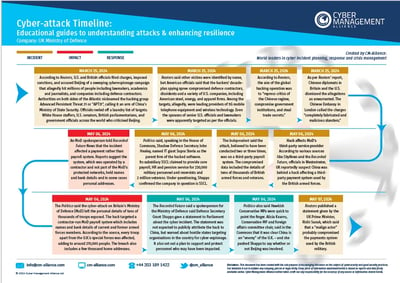UK Armed Forces Data Exposed: MoD Cyber Attack Timeline
Date: 21 May 2024
A third-party payroll system that the UK Ministry of Defence used was recently hacked. The effects of this attack have been severe to say the least. Not only has data of 270,000 serving personnel, as well as reservists and veterans, from all three services been exposed. It has led to massive political furor, besides underlining once again, the growing importance of third-party cybersecurity.
We've covered everything that happened in the three-week long attack by suspected Nation State actors which ultimately targetted the British Armed Forces. The detailed timeline document also covers background on the long-on cyber espionage campaign by Nation State actors that is linked to the data breach of UK MoD. From what government officials have said to questions raised by critics of the present regime, our detailed UK MoD Cyber Attack timeline document and summary image delve into it all.
Get your copy of the UK MoD Cyber Attack Timeline documents.
More than anything, this attack has highlighted the massive need for prioritising third-party security. The European Union's DORA regulation and the updated NIST Cybersecurity Framework 2.0 both stress upon the need for tightening supply chain security. And this incident has put the spotlight on this rampant cybersecurity risk yet again.
Topics covered in this article:
1. About the UK Armed Forces Cyber Attack
2. Lessons Learned from the Attack

Disclaimer: This document has been created with the sole purpose of encouraging discourse on the subject of cybersecurity and good security practices. Our intention is not to defame any company, person or legal entity. Every piece of information mentioned herein is based on reports and data freely available online. Cyber Management Alliance neither takes credit nor any responsibility for the accuracy of any source or information shared herein.
The UK MoD Cyber Attack
The British Armed Forces experienced a significant cyber attack believed to be orchestrated by Chinese hackers. This attack compromised the personal data of approximately 270,000 serving personnel, reservists, and veterans.
Many estimates suggest that the attack has potentially exposed the identities, bank details, and, in some cases, addresses and national insurance numbers of the personnel. The compromise lasted around three weeks before being detected. This fact, by itself, has raised serious concerns about the security of military data and the potential for further exploitation of this information.
In response to the breach, the UK Ministry of Defence took its affected network offline and is providing guidance to those impacted on how to monitor their accounts for suspicious activity.
Prime Minister Rishi Sunak and other officials have highlighted the severity of the incident, with suggestions that a 'malign actor', is behind the attack. This breach follows a broader trend of increasing cyber threats against the UK, with over six million attacks recorded on military networks last year alone. It also intensifies the pressure on organisations and government bodies worldwide to focus on the security of their third-party vendors and their supply chain.

Lessons Learned from the UK Armed Forces Cyber Attack
Attacks that compromise prestigious government organisations and large businesses always rake up one major sentiment - If this could happen to them, how safe are we? The we, in this case, being businesses that probably don't have the same kind of resources, funding and institutional backing.
Does this mean that we're all doomed? Certainly not. What this attack and others like it, which we have documented in our Cyber Attack Timelines, show us is this - Cyber criminals are out to get anyone and everyone. The only sure shot way of securing yourself is through adequate preparation.
If you have staff that is well-trained in Cyber Incident Response and you have a solid Incident Response Plan, you have already insured yourself against major damage. What critics have pointed out in this case is the amount of time it took the Ministry of Defence to detect the anomalous activity. Detection and containment, however, are amongst the foremost steps in Cybersecurity Incident Response and they can make a huge difference to the way a compromise or breach spreads in your system.
Our NCSC Assured Training in Cyber Incident Planning and Response covers these steps, cyber resilience planning, staff awareness and more in greater detail. Through certified training courses such as this, you can make massive leaps in your overall cyber protection. This doesn't mean you won't get attacked. But when you do, your staff and your team of Incident Responders will be well-equipped to deal with it head-on. You'll hopefully be able to control the damage and bounce back without precious data being stolen or too many systems being affected.
Paying attention to third-party security is another key lesson that this attack teaches us. You have to do your due diligence when it comes to onboarding new partners. Ensure that all contracts are water-tight from a data sharing perspective. Get expert cybersecurity consultants on board to help you review your supply chain security and/or third-party contracts. Make this a regular exercise and not a one-time activity.
Small steps such as these can go a long way in securing your business from major cybersecurity incidents that wreak havoc on your bottom line and brand reputation.
In the meanwhile, download our FREE UK MoD Cyber Attack Timeline Document & Summary image to empower yourself with all the knowledge, context and perspective you need to build stronger cyber defences today!

Disclaimer: This document has been created with the sole purpose of encouraging discourse on the subject of cybersecurity and good security practices. Our intention is not to defame any company, person or legal entity. Every piece of information mentioned herein is based on reports and data freely available online. Cyber Management Alliance neither takes credit nor any responsibility for the accuracy of any source or information shared herein.









